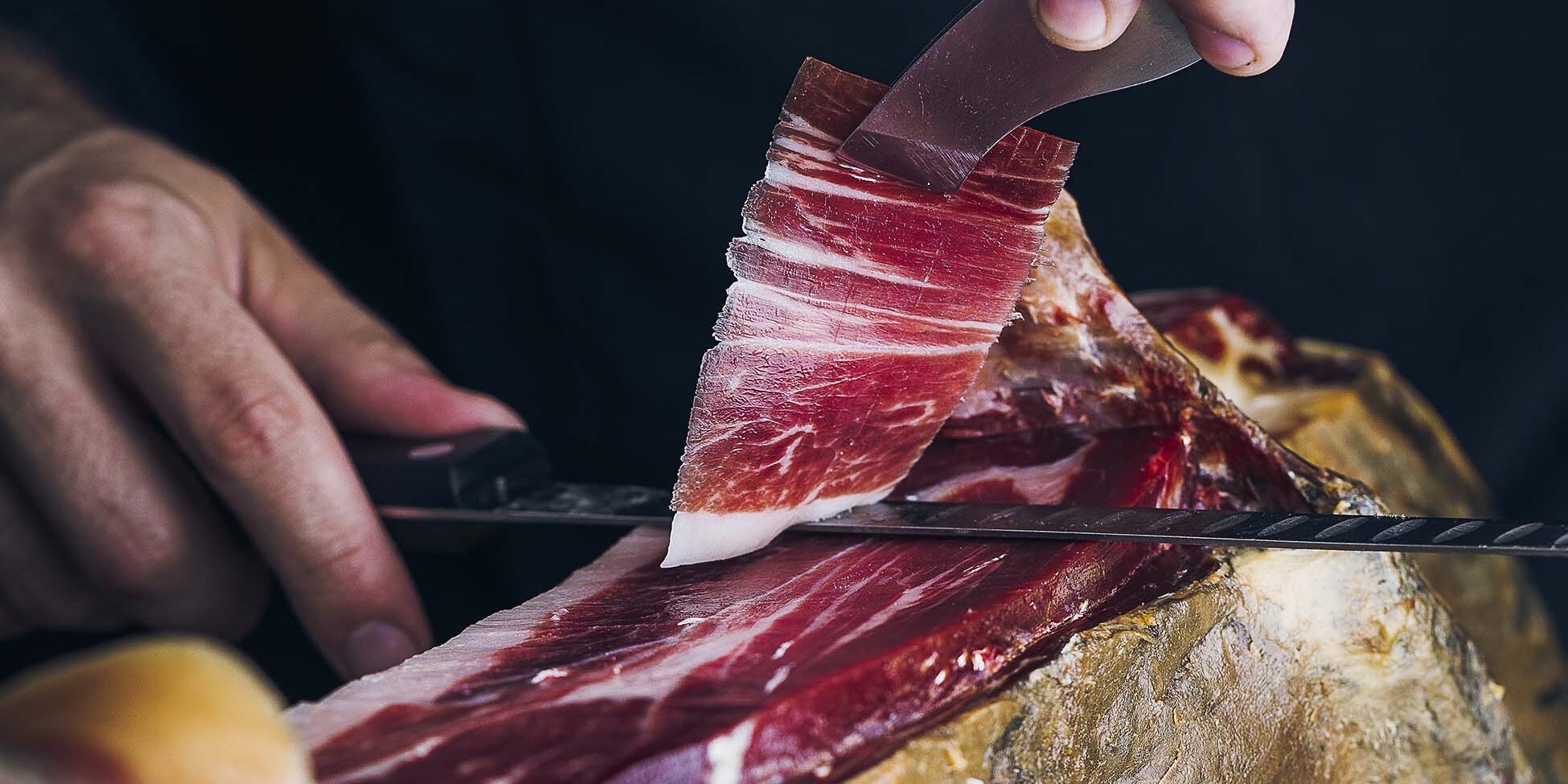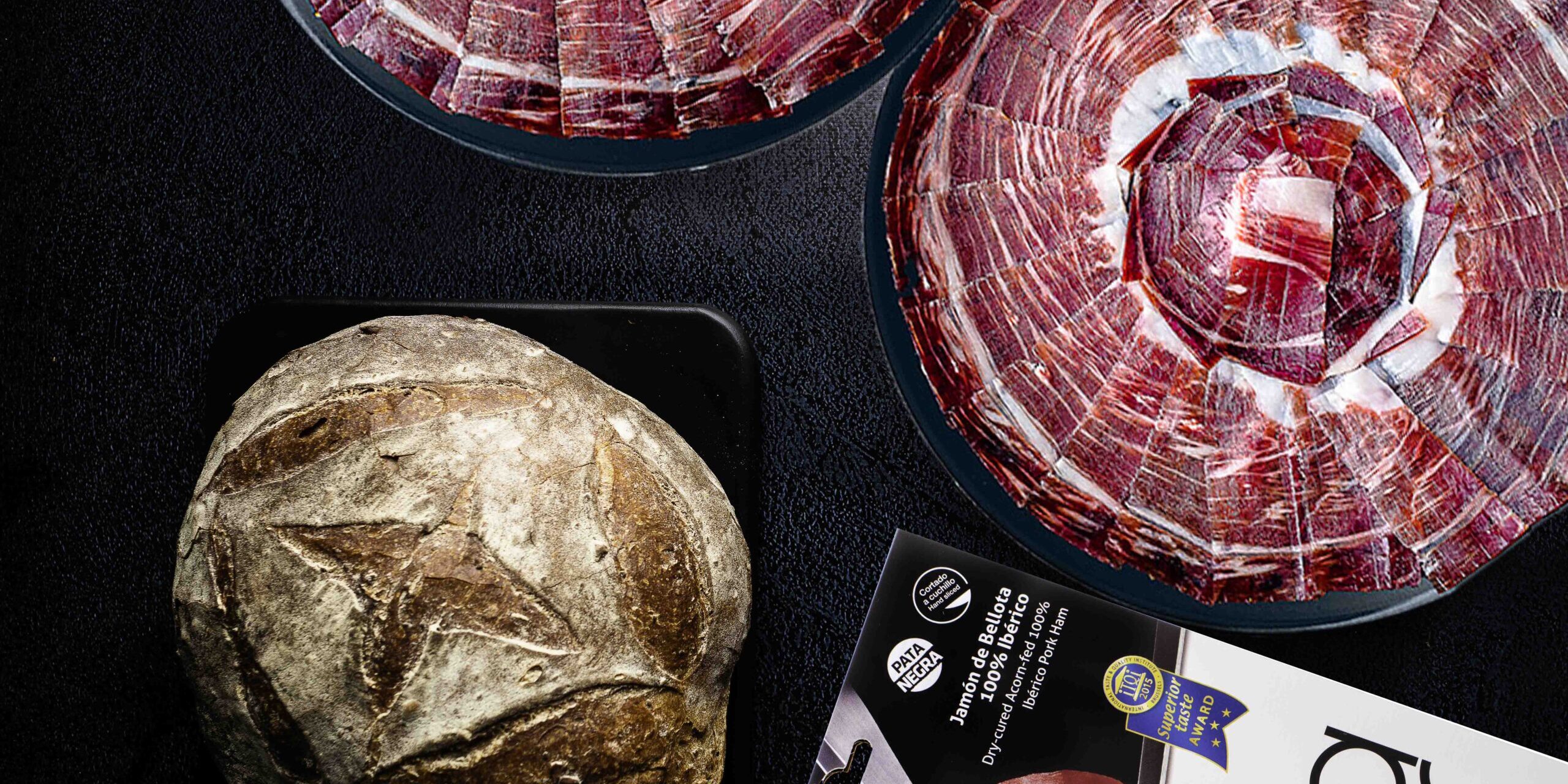To appreciate a unique product like COVAP’s Alta Expresión Bone in Dry-cured Acorn-fed 100% Ibérico Pork Shoulder you need to know how to enjoy it, letting it speak for itself in every cut and tell its story. Allowing you to experience a unique sensation that can’t be put into words.
That’s why we’re going to try to explain, in detail, everything you need to know about its cut, texture, flavors, and the different nuances you can appreciate on the palate. So that, when you taste this delicacy, you can express the sensations it transmits.
However, before we move on the art of cutting one of COVAP’s Alta Expresión Bone in Dry-cured Acorn-fed 100% Ibérico Pork Shoulders, you need to know how to select the best one. Once you have purchased one it’s time to start cutting it.
To start with, you need to take a good look at the physiognomy of the product. A good shoulder has different parts which we will now look at: the shank, flank, hock, shinbone, and hoof.
- Shank: This is the back part of the shoulder. It has a larger amount of lean meat and produces wider slices than the flank.
- Flank: This is found in the front part and is divided into two areas by the humerus bone.
- Hock: This the most fibrous part and is located near the hoof. As it is the thinnest part it is also more aged and, therefore, perfect for cutting into cubes.
- Shinbone: This can be taken as a reference to judge the quality of the shoulder. It should be thin as a sign of all the exercise the pig did, a very important quality to ensure that the meat is marbled with fat.
- Hoof: It should be black which is one of the identifying signs of the Ibérico breed.
Now you know the different parts of COVAP’s Alta Expresión Bone in Dry-cured Acorn-fed 100% Ibérico Pork Shoulder, it’s time to follow step by step instructions on the best way to cut it to enjoy this quality product.
Cutting tools
Once you have your star product, you need the right tools to work on it. You will need the following:
- Ham Knife: Long and flexible to remove the slices.
- A broad-bladed knife: This is used to remove the outer parts of fat and lean meat.
- Paring knife: To make more precise cuts in angular areas and separate the meat from the bone.
- Knife sharpener: To keep your knife edge in the best condition.
- Tongs: Finally, tongs to help you remove the slices and place them on the plate without handling the product too much.
Securing the shoulder
You need to make sure that the Alta Expresión Bone in Dry-cured Acorn-fed 100% Ibérico Pork Shoulder is secured correctly in the ham holder.
Once it is, you need to start removing the outer layers of skin and yellow fat.
If you are going to eat the shoulder over a period of several days (10-15 days), only remove the part of the skin in the area you are going to slice. The rest of the shoulder needs to be left well-preserved.
On the other hand, if you are going to eat all of it on the same day, you can remove all the skin and fat, leaving the whole shoulder ready for cutting.
*Note: The white fat that appears under the layers of yellow fat should not be removed. This is the healthy fat that the COVAP’s Alta Expresión Bone in Dry-cured Acorn-fed 100% Ibérico Pork Shoulder provides.
Cutting the flank
You need to start cutting from the part closest to the hoof. At first, the slices will be smaller and they will grow in size as you continue to cut.
The movement of the knife while cutting should be gentle and with one hand, without applying much force. Your free hand should only be used to remove the slices and place them on the plate.
It is essential that the slices you cut have part of the healthy fat next to the lean meat. This allows all the nuances of the product to be appreciated.
Once you have finished cutting between the area close to the hoof and the humerus bone, which will appear in the center, move on to slice the part located between the other side of this bone and the shoulder blade. This finishes off the flank.
Preserving the shoulder
To preserve a shoulder that has been started, you can use the outer layers of fat that you took off before you started to slice the shoulder. Keeping the white fat in contact with the lean meat. In this way, the fat will nourish the shoulder and stop it drying out.
You can also use cling film with a cotton cloth on top to protect it from the light and contact with the air.
Cutting the shank
Once you have finished the flank, turn the shoulder around and start to slice the shank. To do this, start the process that was carried out with the flank.
You also need to be careful when plating up the ham. The slices are placed next to each other and always with the marbling following in the same direction.
Third Cut
To start the third cut, you need to turn the shoulder again and keep the fatty part facing upwards. Your knife will now be vertical when you cut instead of horizontal.
Cutting the hock
This part is particularly flavorful. This cut signals the end of the cutting of the main parts of your COVAP Alta Expresión Bone in Dry-cured Acorn-fed 100% Ibérico Pork Shoulder.
Cutting shoulder cubes
Once you have finished with the main cuts of the shoulder, get the most out of the product by using every part of it.
The part located in the scapular spine, next to the remaining lean meat, can be cut into cubes.
Likewise, you can also use the fat, a product that provides high oleic acid content, or the bone to make different types of stock.
This last point brings us to the end of our step by step instructions on how to cut a COVAP Alta Expresión Bone in Dry-cured Acorn-fed 100% Ibérico Pork Shoulder
Finally, you just need to know how to serve the shoulder to delight your guests and offer them a quality product that has been treated in the best possible way.
If you would like to know more about the parts of the shoulder, how to cut a shoulder and how to serve a COVAP Alta Expresión Bone in Dry-cured Acorn-fed 100% Ibérico Pork Shoulder, just follow the steps in our expert ham cutter’s video.





